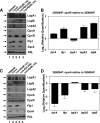Characterization of the CpxRA regulon in Haemophilus ducreyi
- PMID: 20805330
- PMCID: PMC2976327
- DOI: 10.1128/IAI.00678-10
Characterization of the CpxRA regulon in Haemophilus ducreyi
Abstract
The Haemophilus ducreyi 35000HP genome encodes a homolog of the CpxRA two-component cell envelope stress response system originally characterized in Escherichia coli. CpxR, the cytoplasmic response regulator, was shown previously to be involved in repression of the expression of the lspB-lspA2 operon (M. Labandeira-Rey, J. R. Mock, and E. J. Hansen, Infect. Immun. 77:3402-3411, 2009). In the present study, the H. ducreyi CpxR and CpxA proteins were shown to closely resemble those of other well-studied bacterial species. A cpxA deletion mutant and a CpxR-overexpressing strain were used to explore the extent of the CpxRA regulon. DNA microarray and real-time reverse transcriptase (RT) PCR analyses indicated several potential regulatory targets for the H. ducreyi CpxRA two-component regulatory system. Electrophoretic mobility shift assays (EMSAs) were used to prove that H. ducreyi CpxR interacted with the promoter regions of genes encoding both known and putative virulence factors of H. ducreyi, including the lspB-lspA2 operon, the flp operon, and dsrA. Interestingly, the use of EMSAs also indicated that H. ducreyi CpxR did not bind to the promoter regions of several genes predicted to encode factors involved in the cell envelope stress response. Taken together, these data suggest that the CpxRA system in H. ducreyi, in contrast to that in E. coli, may be involved primarily in controlling expression of genes not involved in the cell envelope stress response.
Figures




Similar articles
-
Activation of CpxRA in Haemophilus ducreyi primarily inhibits the expression of its targets, including major virulence determinants.J Bacteriol. 2013 Aug;195(15):3486-502. doi: 10.1128/JB.00372-13. Epub 2013 May 31. J Bacteriol. 2013. PMID: 23729647 Free PMC article.
-
Regulation of expression of the Haemophilus ducreyi LspB and LspA2 proteins by CpxR.Infect Immun. 2009 Aug;77(8):3402-11. doi: 10.1128/IAI.00292-09. Epub 2009 May 18. Infect Immun. 2009. PMID: 19451237 Free PMC article.
-
The Haemophilus ducreyi Fis protein is involved in controlling expression of the lspB-lspA2 operon and other virulence factors.Infect Immun. 2013 Nov;81(11):4160-70. doi: 10.1128/IAI.00714-13. Epub 2013 Aug 26. Infect Immun. 2013. PMID: 23980107 Free PMC article.
-
A Haemophilus ducreyi CpxR deletion mutant is virulent in human volunteers.J Infect Dis. 2011 Jun 15;203(12):1859-65. doi: 10.1093/infdis/jir190. J Infect Dis. 2011. PMID: 21606544 Free PMC article.
-
Activation of the CpxRA system by deletion of cpxA impairs the ability of Haemophilus ducreyi to infect humans.Infect Immun. 2010 Sep;78(9):3898-904. doi: 10.1128/IAI.00432-10. Epub 2010 Jul 6. Infect Immun. 2010. PMID: 20605985 Free PMC article.
Cited by
-
Haemophilus ducreyi RpoE and CpxRA appear to play distinct yet complementary roles in regulation of envelope-related functions.J Bacteriol. 2014 Dec;196(23):4012-25. doi: 10.1128/JB.02034-14. Epub 2014 Sep 8. J Bacteriol. 2014. PMID: 25201944 Free PMC article.
-
Reciprocal regulation of resistance-nodulation-division efflux systems and the Cpx two-component system in Vibrio cholerae.Infect Immun. 2014 Jul;82(7):2980-91. doi: 10.1128/IAI.00025-14. Epub 2014 May 5. Infect Immun. 2014. PMID: 24799626 Free PMC article.
-
HtrA Is Important for Stress Resistance and Virulence in Haemophilus parasuis.Infect Immun. 2016 Jul 21;84(8):2209-2219. doi: 10.1128/IAI.00147-16. Print 2016 Aug. Infect Immun. 2016. PMID: 27217419 Free PMC article.
-
Functional Analysis of preA in Aeromonas veronii TH0426 Reveals a Key Role in the Regulation of Virulence and Resistance to Oxidative Stress.Int J Mol Sci. 2019 Dec 21;21(1):98. doi: 10.3390/ijms21010098. Int J Mol Sci. 2019. PMID: 31877791 Free PMC article.
-
Phosphorylated CpxR restricts production of the RovA global regulator in Yersinia pseudotuberculosis.PLoS One. 2011;6(8):e23314. doi: 10.1371/journal.pone.0023314. Epub 2011 Aug 18. PLoS One. 2011. PMID: 21876746 Free PMC article.
References
-
- Al-Tawfiq, J. A., K. R. Fortney, B. P. Katz, A. F. Hood, C. Elkins, and S. M. Spinola. 2000. An isogenic hemoglobin receptor-deficient mutant of Haemophilus ducreyi is attenuated in the human model of experimental infection. J. Infect. Dis. 181:1049-1054. - PubMed
-
- Altschul, S. F., W. Gish, W. Miller, E. W. Myers, and D. J. Lipman. 1990. Basic local alignment search tool. J. Mol. Biol. 215:403-410. - PubMed
-
- Aravind, L., and C. P. Ponting. 1999. The cytoplasmic helical linker domain of receptor histidine kinase and methyl-accepting proteins is common to many prokaryotic signalling proteins. FEMS Microbiol. Lett. 176:111-116. - PubMed
-
- Banks, K. E., K. R. Fortney, B. Baker, S. D. Billings, B. P. Katz, R. S. J. Munson, and S. M. Spinola. 2008. The enterobacterial common antigen-like gene cluster of Haemophilus ducreyi contributes to virulence in humans. J. Infect. Dis. 197:1531-1536. - PubMed
Publication types
MeSH terms
Substances
Associated data
- Actions
- Actions
Grants and funding
LinkOut - more resources
Full Text Sources
Other Literature Sources
Molecular Biology Databases

